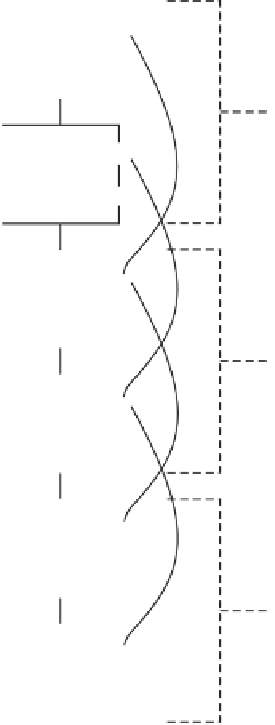Environmental Engineering Reference
In-Depth Information
applied can be written in terms of the stress in the Hookean
portion plus the stress in the Maxwell portion of
16.11.3 Mathematical Model for Multilayer System
A transient flow process such as consolidation takes place as
a result of total load (or stress) being applied to the soil. In
an unsaturated soil with one-way drainage through the top,
both water and air will move upward from a lower layer
toward an uppermost, lower pressure boundary. The water
and the air phases are assumed to be continuous through-
out the soil. This process is illustrated using the three-layer
system shown in Fig. 16.65.
The linear rheological elements associated with the stress
state variables
σ
the
model:
η
w
˙
ε
c
σ
=
σ
H
+
ε
w
−˙
(16.90)
where:
ε
c
=
strain in the Hookean spring of the Maxwell
portion of the model which is related to the com-
pressibility of water,
u
a
in the
n
-layer strata can
be separated into two parts. An equivalency for the linear
rheological elements is shown in Fig. 16.66. For simplicity,
the compressibility of the air phase and the permeability of
the water phase are assumed to be constant values.
The compressibility of water and air is simulated using
Hookean springs. In both the water and air phases, only
the bottom layer is truly a linear rheological element. The
−
u
w
and
σ
−
ε
w
=
strain in the dashpot due to the flow of water,
ε
w
,
˙
ε
c
=
˙
derivatives of
ε
w
and
ε
c
, respectively, and
η
w
=
dashpot constant for the water phase.
Constitutive relations can be written for the components
of the rheological model.
σ
H
=
κ
w
ε
w
(16.91)
σ
M
=
c
w
ε
c
(16.92)
σ
where:
η
w
κ
w
=
Hookean spring constant related to the compress-
ibility of the soil with respect to a change in
σ
k
w
σ
-
u
w
−
u
w
c
w
and
Layer 1
c
w
=
Hookean spring constant related to the bulk com-
pressibility of water.
η
a
k
σ
-
u
a
a
Equation 16.90 can be rearranged to give a rate of strain
condition for the linear rheological element associated with
σ
c
a
−
u
w
:
σ
M
c
w
=
˙
σ
˙
−˙
σ
H
c
w
0
−˙
σ
H
c
w
κ
w
c
w
˙
σ
-
u
w
ε
˙
=
=
=−
ε
w
(16.93)
Layer 2
A similar rate of strain condition can be written for the
linear rheological element associated with
σ
−
u
a
.
σ
-
u
a
16.11.2 Differential Equations for linear Rheological
Elements of Single Layer
The stress-strain equation for the linear rheological element
associated with
σ
−
u
w
can be written as
σ
-
u
w
1
1
exp
t
σ
κ
w
+
c
w
κ
w
κ
w
c
w
ε
w
=
+
−
−
η
w
κ
w
+
c
w
c
w
Layer 3
(16.94)
The stress-strain equation for the linear rheological ele-
ment associated with
σ
σ
-
u
a
−
u
a
can be written as
1
1
exp
t
σ
κ
a
+
c
a
κ
a
κ
a
c
a
η
a
κ
a
+
σ
ε
a
=
+
−
−
c
a
c
a
Figure 16.65
Three-layer rheological system demonstrating one-
dimensional consolidation process in unsaturated soil.
(16.95)














Search WWH ::

Custom Search